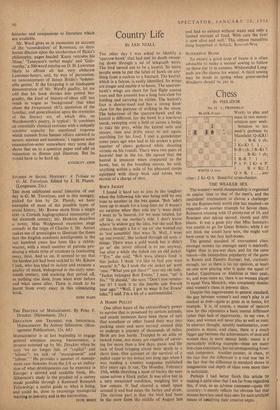Country Life
BY IAN NIALL
TILE other day I was asked to identify a 'sparrow-hawk' that had met its death swoop- ing down through a set of telegraph wires. The bird turned out to be a kestrel. So many people seem to put the label of hawk on any- thing from a cuckoo to a buzzard. The kestrel, which is a falcon, is easily identified. Its wings are longer and enable it to hover. The sparrow- hawk's wings are short for fast flight among trees and this assassin has a long fore-claw for holding and carrying its victim. The kestrel's foot is shorter-toed and has a strong hind- claw for the purpose of striking in the stoop. The behaviour of the sparrow-hawk and the kestrel is different, for the hawk 'is a low-level sneak, sweeping over a field or across a hedge to take his prey, while the kestrel sails and stoops, rises and drifts away to sail again. searching for his food. I met a gamekeeper some years ago who had in his pocket a great number of claws gathered while shooting vermin on his rounds. There were two pairs of kestrels' feet in the lot. 'He agreed that the kestrel is innocent when compared to the hawk, but, in the breeding season, he said. anything within a mile of his pheasant coops equipped with sharp beak and talons was certain of a charge of shot.


































 Previous page
Previous page